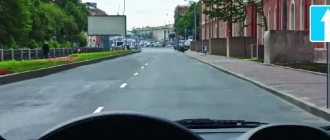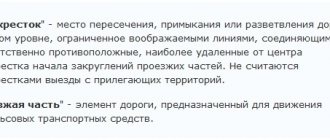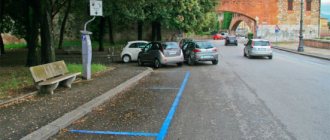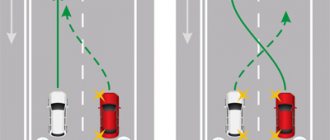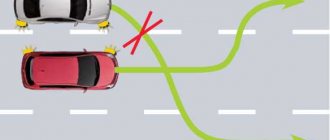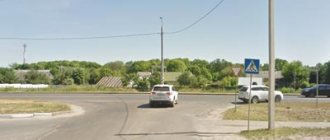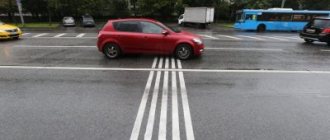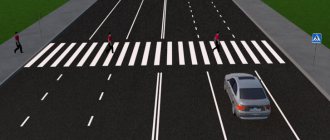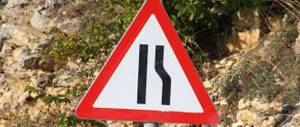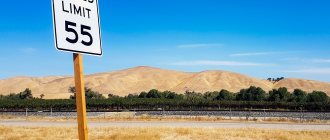9.2. On dual carriageway roads with four or more lanes, it is prohibited to overtake or pass into the lane intended for oncoming traffic. On such roads, left turns or U-turns may be made at intersections and in other places where this is not prohibited by the Rules, signs and (or) markings.
On four-lane roads, all lanes can be marked with markings (double solid line to separate oncoming traffic - 1.3 and dotted lines 1.5 or solid lines 1.1 to separate passing directions.
Four lanes are marked
- It is possible to designate only a double solid line - 1.3 in the center to separate the flows, while in accordance with the purpose of marking 1.3, the road will have four or more lanes.
Four lanes marked with double solid only
Determining a four-lane road without markings is possible only by knowing the exact width of the roadway. According to the standards, the width of each lane of such a road is 3.5 meters, but in some conditions it may be narrowed to 3 meters. Thus, the minimum width of two-sided
the roadway for the application of paragraph 9.2 of the Traffic Rules is 12 meters.
If there are no markings on two or three-lane roads, following paragraph 9.1 of the Rules, driving in four lanes is possible. These lanes are determined by drivers. Their number may vary depending on the size of the vehicles, the speed of travel and the selected safe interval. On the road, the number of lanes will be the same as designed and built. It is unlawful to apply paragraph 9.2 when qualifying violations on roads less than 12 meters wide.
Driver-defined lanes
All illustrations above show a typical road with four lanes and a width of 14 meters. The slower the speed, the denser the vehicles move.
The downside is that if driving on a four-lane road in the far right lane is impossible (road works, obstacles in the form of snowdrifts, etc.), such a road does not become narrower than the width of the obstacle.
The minimum width of a two-way carriageway with 4 lanes is 12 meters.
Transitional express lanes, additional ascending lanes, and drive-in pockets of route vehicle stopping places are not taken into account in accordance with clause 9.1 of the Rules.
Oncoming traffic is prohibited
Clause 9.2 establishes a ban on entering the oncoming lane to overtake or bypass - this list of maneuvers is limited and does not have any allowances for avoiding obstacles, even if this is impossible within the oncoming lane. In this case, it is impossible to bypass the obstacle without violating the Traffic Rules. Moreover, the presence or absence of markings does not matter. However, such a violation of the Rules will not entail an administrative offense, that is, it is unlawful to fine for such a violation.
Avoiding obstacles is prohibited by the Rules
It is possible to organize traffic in the oncoming lane on roads with dividing strips or tram tracks (more about tram tracks in the commentary to the term “Roadway”). For this purpose, road signs 6.19.1 or 6.19.2 are used - “Preliminary indicator for changing lanes onto another roadway.”
Organized departure into the oncoming lane
Chapter 9: Location of vehicles on the roadway
- Current as of 05/29/2021
- Revision dated November 24, 2018
- Approved 10/23/1993
9.1. The number of lanes for trackless vehicles is determined by markings and (or) signs 5.15.1, 5.15.2, 5.15.7, 5.15.8, and if there are none, then by the drivers themselves, taking into account the width of the roadway, vehicle dimensions and required intervals between them. In this case, the side intended for oncoming traffic on two-way roads without a dividing strip is considered to be half the width of the roadway located on the left, not counting local widenings of the roadway (transition and express lanes, additional lanes on the rise, drive-in pockets of stops for route vehicles ).
5.15.1
5.15.8
5.15.2
5.15.7
9.1(1). On any two-way roads, driving in the lane intended for oncoming traffic is prohibited if it is separated by tram tracks, a dividing strip, markings 1.1, 1.3 or markings 1.11, the broken line of which is located on the left.
9.2. On dual carriageway roads with four or more lanes, it is prohibited to overtake or pass into the lane intended for oncoming traffic. On such roads, left turns or U-turns may be made at intersections and in other places where this is not prohibited by the Rules, signs and (or) markings.
9.3. On two-way roads that have three lanes marked with markings (except for marking 1.9), of which the middle one is used for traffic in both directions, it is allowed to enter this lane only for overtaking, bypassing, turning left or making a U-turn. It is prohibited to enter the leftmost lane intended for oncoming traffic.
Markup 1.9
9.4. Outside populated areas, as well as in populated areas on roads marked with signs 5.1 or 5.3 or where driving at a speed of more than 80 km/h is permitted, vehicle drivers must drive them as close as possible to the right edge of the roadway. It is prohibited to occupy the left lanes when the right lanes are free.
| 5.1 | 5.3 |
In populated areas, taking into account the requirements of this paragraph and paragraphs 9.5, 16.1 and 24.2 of the Rules, vehicle drivers can use the lane that is most convenient for them. In heavy traffic, when all lanes are occupied, changing lanes is only allowed to turn left or right, make a U-turn, stop, or avoid an obstacle.
However, on any roads that have three or more lanes for traffic in a given direction, the leftmost lane is allowed to occupy only in heavy traffic, when other lanes are occupied, as well as for turning left or making a U-turn, and for trucks with a permissible maximum weight of more than 2.5 t - only for turning left or making a U-turn. Entering the left lane of one-way roads to stop and park is carried out in accordance with paragraph 12.1 of the Rules.
9.5. Vehicles whose speed should not exceed 40 km/h or which for technical reasons cannot reach such a speed must move in the far right lane, except in cases of detour, overtaking or changing lanes before turning left, making a U-turn or stopping in permitted cases on the left side roads.
9.6. It is allowed to travel on tram tracks in the same direction, located on the left at the same level as the roadway, when all lanes in this direction are occupied, as well as when making a detour, turning left or making a U-turn, taking into account clause 8.5 of the Rules. In this case, there should be no interference with the tram. It is prohibited to drive onto tram tracks in the opposite direction. If road signs 5.15.1 or 5.15.2 are installed in front of the intersection, movement on tram tracks through the intersection is prohibited.
| 5.15.1 | 5.15.2 |
9.7. If the roadway is divided into stripes by marking lines, the movement of vehicles must be carried out strictly along the designated lanes. It is allowed to drive over broken marking lines only when changing lanes.
9.8. When turning onto a road with reverse traffic, the driver must drive the vehicle in such a way that when leaving the intersection of roadways, the vehicle takes the far right lane. Changing lanes is permitted only after the driver is convinced that traffic in this direction is also permitted in other lanes.
9.9. The movement of vehicles on dividing strips and shoulders, sidewalks and pedestrian paths is prohibited (except for the cases provided for in paragraphs 12.1, 24.2 - 24.4, 24.7, 25.2 of the Rules), as well as the movement of motor vehicles (except mopeds) on lanes for cyclists. The movement of motor vehicles on bicycle and bicycle-pedestrian paths is prohibited. The movement of vehicles of road maintenance and utility services is allowed, as well as access along the shortest route for vehicles delivering cargo to trade and other enterprises and facilities located directly next to the roadsides, sidewalks or pedestrian paths, in the absence of other access options. At the same time, traffic safety must be ensured.
9.10. The driver must maintain such a distance from the vehicle in front that would allow him to avoid a collision, as well as the necessary lateral interval to ensure traffic safety.
9.11. Outside populated areas on dual carriageway roads with two lanes, the driver of a vehicle for which a speed limit has been established, as well as the driver of a vehicle (vehicle combination) longer than 7 m, must maintain such a distance between himself and the vehicle moving ahead that overtaking vehicles could move into the lane they previously occupied without interference. This requirement does not apply when driving on sections of roads where overtaking is prohibited, as well as during heavy traffic and movement in an organized transport convoy.
9.12. On two-way roads, in the absence of a dividing strip, traffic islands, bollards and elements of road structures (supports of bridges, overpasses, etc.) located in the middle of the roadway, the driver must drive around on the right, unless signs and markings indicate otherwise.
PrevChapter 8: Starting movement, maneuvering
Chapter 10: Movement SpeedNext
0/50 ratings
Turns and U-turns are allowed
Next comes an interesting proposal about turns and turns - these maneuvers are allowed in the absence of prohibitions by the Rules. This sentence was added due to the frequent practice of attracting drivers for “entering the oncoming lane in violation of the rules” with subsequent deprivation of their driver’s license. In fact, a turn is crossing the oncoming lane, and a U-turn is changing the oncoming lane to the passing lane. Logically, there is no talk about any driving into the oncoming lane. At the same time, the Code of Administrative Offenses divided responsibility for driving into the oncoming lane in violation of traffic rules and fines for turning or turning around.
Three-lane road with intermittent continuous
A variant of three-lane traffic, in which each lane is marked with a broken line, is not often encountered, but is present on our roads. In this case, the location of vehicles on the roadway (traffic regulations emphasize this) in the middle lane is permitted for motorists traveling in both directions. But they must take into account that when entering the middle lane, they are making a permitted exit into oncoming traffic. Therefore, the assessment of the situation on the road must be especially careful.
The rules strictly prohibit vehicles from driving into the oncoming traffic zone (the far left lane) of a three-lane road with intermittent markings. The offense is punishable by confiscation of the driver's license for a period of four to six months.
How is it possible to make a U-turn on a road like this? It can be prohibited by a special sign, traffic rules or markings. If it is intermittent, there are no signs, the rules prohibit only overtaking or going around a sudden obstacle, then a U-turn and a left turn are possible. You can do it from the middle lane, from the right lane or from the side of the road. Before these maneuvers, you need to make sure they are safe.
Incorrect location of the vehicle on the roadway
It always involves the imposition of a fine. Today it is 1,500 rubles.
Slow-moving vehicles that are technically incapable of reaching speeds above 30 km/h, as well as vehicles carrying large cargo, are required (according to traffic regulations) to give the opportunity to pass or overtake (overtake) the following vehicles. Failure to comply with this requirement is also subject to a fine (1,500 rubles).
Driving a vehicle on sidewalks, pedestrian or bicycle paths also involves a fine. Placing vehicles on the roadway, and in the oncoming lane, to avoid obstacles is punishable by a fine of one thousand to one and a half rubles.
Driving onto the rails in the opposite direction, as well as into the zone of oncoming traffic, is punishable by a fine of five thousand rubles, or the confiscation of the driver’s license for a period of four to six months (except for the case described above). A repeated violation recorded by any means of automatic photo or video recording will entail a fine of 5,000 rubles. If the violation is witnessed by an inspector, the right to drive a vehicle will be deprived for a year.
